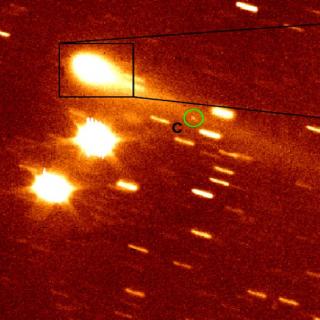Bibcode
Grundy, W. M.; Wong, I.; Glein, C. R.; Protopapa, S.; Holler, B. J.; Cook, J. C.; Stansberry, J. A.; Lunine, J. I.; Parker, A. H.; Hammel, H. B.; Milam, S. N.; Brunetto, R.; Pinilla-Alonso, N.; de Souza Feliciano, A. C.; Emery, J. P.; Licandro, J.
Referencia bibliográfica
Icarus
Fecha de publicación:
3
2024
Revista
Número de citas
28
Número de citas referidas
26
Descripción
James Webb Space Telescope's NIRSpec infrared imaging spectrometer observed the outer solar system dwarf planets Eris and Makemake in reflected sunlight at wavelengths spanning 1 through 5 μm. Both objects have high albedo surfaces that are rich in methane ice, with a texture that permits long optical path lengths through the ice for solar photons. There is evidence for N2 ice absorption around 4.2 μm on Eris, though not on Makemake. No CO ice absorption is seen at 4.67 μm on either body. For the first time, absorption bands of two heavy isotopologues of methane are observed at 2.615 μm (13CH4), 4.33 μm (12CH3D), and 4.57 μm (12CH3D). These bands enable us to measure D/H ratios of (2.5 ± 0.5) × 10-4 and (2.9 ± 0.6) × 10-4, along with 13C/12C ratios of 0.012 ± 0.002 and 0.010 ± 0.003 in the surface methane ices of Eris and Makemake, respectively. The measured D/H ratios are much lower than that of presumably primordial methane in comet 67P/Churyumov-Gerasimenko, but they are similar to D/H ratios in water in many comets and larger outer solar system objects. This similarity suggests that the hydrogen atoms in methane on Eris and Makemake originated from water, indicative of geochemical processes in past or even ongoing hot environments in their deep interiors. The 13C/12C ratios are consistent with commonly observed solar system values, suggesting no substantial enrichment in 13C as could happen if the methane currently on their surfaces was the residue of a much larger inventory that had mostly been lost to space. Possible explanations include geologically recent outgassing from the interiors as well as processes that cycle the surface methane inventory to keep the uppermost surfaces refreshed.
Proyectos relacionados

Pequeños Cuerpos del Sistema Solar
Este Proyecto estudia las propiedades físicas y composicionales de los llamados pequeños cuerpos del Sistema Solar, que incluyen asteroides, objetos helados y cometas. Entre los grupos de mayor interés destacan los objetos trans-neptunianos (TNOs), incluyendo los objetos más lejanos detectados hasta la fecha (Extreme-TNOs o ETNOs); los cometas, y
Julia de
León Cruz